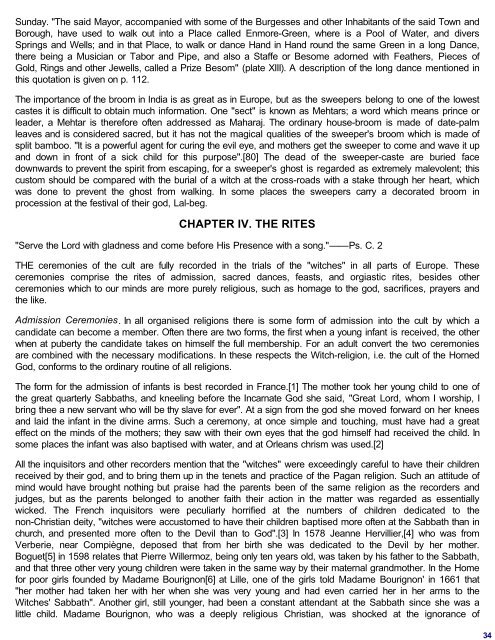THE GOD OF THE WITCHES - World eBook Library - World Public ...
THE GOD OF THE WITCHES - World eBook Library - World Public ...
THE GOD OF THE WITCHES - World eBook Library - World Public ...
Create successful ePaper yourself
Turn your PDF publications into a flip-book with our unique Google optimized e-Paper software.
Sunday. "The said Mayor, accompanied with some of the Burgesses and other Inhabitants of the said Town and<br />
Borough, have used to walk out into a Place called Enmore-Green, where is a Pool of Water, and divers<br />
Springs and Wells; and in that Place, to walk or dance Hand in Hand round the same Green in a long Dance,<br />
there being a Musician or Tabor and Pipe, and also a Staffe or Besome adorned with Feathers, Pieces of<br />
Gold, Rings and other Jewells, called a Prize Besom" (plate XIII). A description of the long dance mentioned in<br />
this quotation is given on p. 112.<br />
The importance of the broom in India is as great as in Europe, but as the sweepers belong to one of the lowest<br />
castes it is difficult to obtain much information. One "sect" is known as Mehtars; a word which means prince or<br />
leader, a Mehtar is therefore often addressed as Maharaj. The ordinary house-broom is made of date-palm<br />
leaves and is considered sacred, but it has not the magical qualities of the sweeper's broom which is made of<br />
split bamboo. "It is a powerful agent for curing the evil eye, and mothers get the sweeper to come and wave it up<br />
and down in front of a sick child for this purpose".[80] The dead of the sweeper-caste are buried face<br />
downwards to prevent the spirit from escaping, for a sweeper's ghost is regarded as extremely malevolent; this<br />
custom should be compared with the burial of a witch at the cross-roads with a stake through her heart, which<br />
was done to prevent the ghost from walking. In some places the sweepers carry a decorated broom in<br />
procession at the festival of their god, Lal-beg.<br />
CHAPTER IV. <strong>THE</strong> RITES<br />
"Serve the Lord with gladness and come before His Presence with a song."——Ps. C. 2<br />
<strong>THE</strong> ceremonies of the cult are fully recorded in the trials of the "witches" in all parts of Europe. These<br />
ceremonies comprise the rites of admission, sacred dances, feasts, and orgiastic rites, besides other<br />
ceremonies which to our minds are more purely religious, such as homage to the god, sacrifices, prayers and<br />
the like.<br />
Admission Ceremonies. In all organised religions there is some form of admission into the cult by which a<br />
candidate can become a member. Often there are two forms, the first when a young infant is received, the other<br />
when at puberty the candidate takes on himself the full membership. For an adult convert the two ceremonies<br />
are combined with the necessary modifications. In these respects the Witch-religion, i.e. the cult of the Horned<br />
God, conforms to the ordinary routine of all religions.<br />
The form for the admission of infants is best recorded in France.[1] The mother took her young child to one of<br />
the great quarterly Sabbaths, and kneeling before the Incarnate God she said, "Great Lord, whom I worship, I<br />
bring thee a new servant who will be thy slave for ever". At a sign from the god she moved forward on her knees<br />
and laid the infant in the divine arms. Such a ceremony, at once simple and touching, must have had a great<br />
effect on the minds of the mothers; they saw with their own eyes that the god himself had received the child. In<br />
some places the infant was also baptised with water, and at Orleans chrism was used.[2]<br />
All the inquisitors and other recorders mention that the "witches" were exceedingly careful to have their children<br />
received by their god, and to bring them up in the tenets and practice of the Pagan religion. Such an attitude of<br />
mind would have brought nothing but praise had the parents been of the same religion as the recorders and<br />
judges, but as the parents belonged to another faith their action in the matter was regarded as essentially<br />
wicked. The French inquisitors were peculiarly horrified at the numbers of children dedicated to the<br />
non-Christian deity, "witches were accustomed to have their children baptised more often at the Sabbath than in<br />
church, and presented more often to the Devil than to God".[3] In 1578 Jeanne Hervillier,[4] who was from<br />
Verberie, near Compiègne, deposed that from her birth she was dedicated to the Devil by her mother.<br />
Boguet[5] in 1598 relates that Pierre Willermoz, being only ten years old, was taken by his father to the Sabbath,<br />
and that three other very young children were taken in the same way by their maternal grandmother. In the Home<br />
for poor girls founded by Madame Bourignon[6] at Lille, one of the girls told Madame Bourignon' in 1661 that<br />
"her mother had taken her with her when she was very young and had even carried her in her arms to the<br />
Witches' Sabbath". Another girl, still younger, had been a constant attendant at the Sabbath since she was a<br />
little child. Madame Bourignon, who was a deeply religious Christian, was shocked at the ignorance of<br />
34















